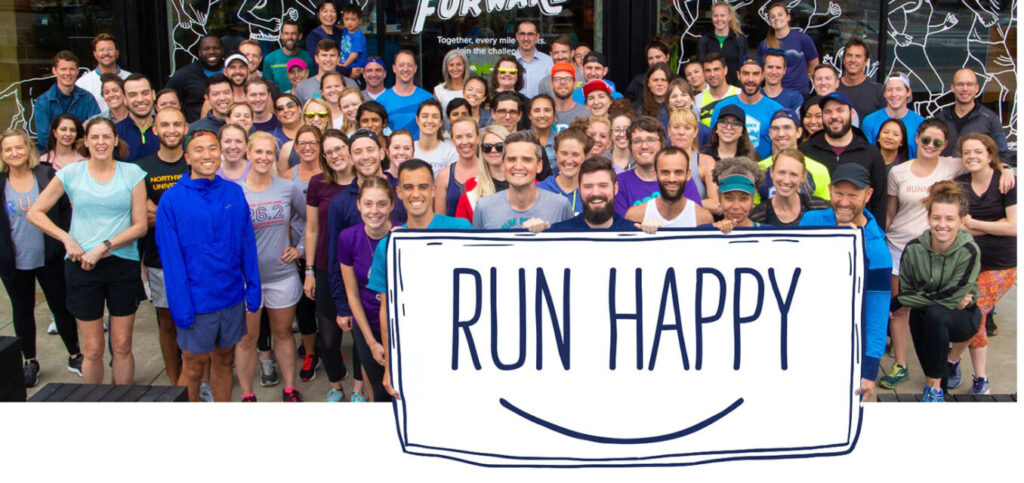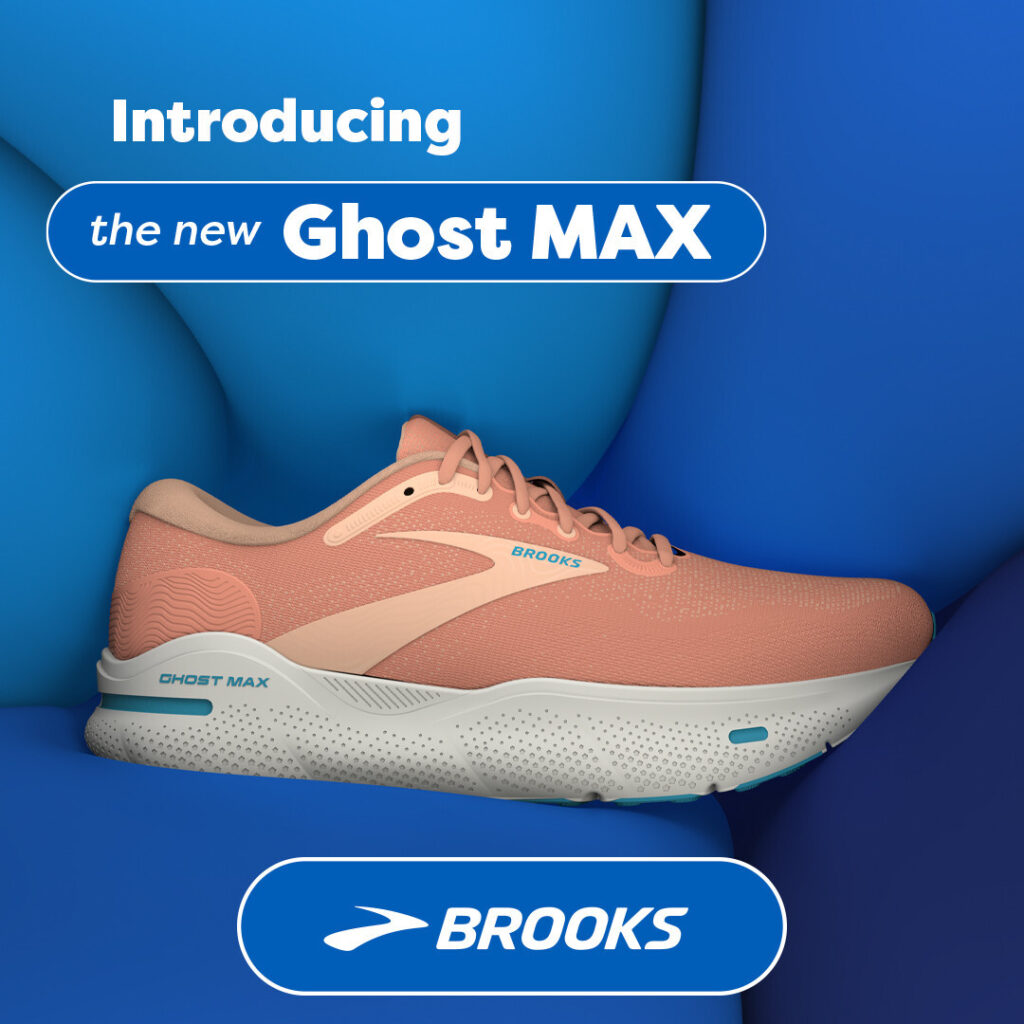Reading For Runners

5 benefits of running for your mind, body, and soul
Here are five holistic, whole-body benefits runners can look forward to on the roads (or trails).
1. Running can improve your heart and lungs
There aren’t many activities that benefit your cardiovascular system more than running, and it doesn’t take long to reap those benefits. A study published in the Journal of the American College of Cardiology concluded that running, even five to 10 minutes a day and at less than 6 miles per hour, is associated with a markedly reduced risk of death from all causes and cardiovascular disease.
When you run, your lungs bring oxygen into your body. This supplies energy and removes carbon dioxide, the waste product created when you produce energy. Your heart then pumps oxygen to the muscles you use to run. According to the American Lung Association, your body becomes more efficient at getting oxygen into the bloodstream and transporting it to the working muscles as you become more physically fit. That’s one of the reasons you are less likely to become short of breath during exercise over time.
Running can also strengthen the diaphragm and muscles between the ribs that work together to power inhaling and exhaling. Breathing exercises like pursed lip breathing or belly breathing can also make your lungs more efficient.
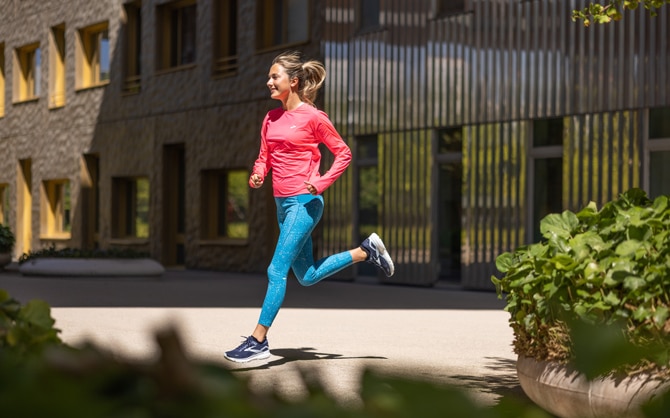
2. Running can improve your muscle and bone strength
When you run, you’re putting big muscle groups to work, like your glutes, hamstrings and quads, making them all stronger and more useful during everyday activities. The most obvious bodily beneficiary to staying in stride are your legs. They stand the most to gain from regular runs. They are also the most vulnerable to injury, so it’s important to take care of them while you’re training. Brooks Beasts athletic trainer Sarah Bair focuses on three key mechanisms to help runners avoid injury: soft tissue elasticity, joint mobility and muscle activation.
You also pull in your core muscles, and even smaller muscle groups you might not recognise, like your back, hips, calf muscles, and even your upper body. Working on your core muscles (abdominals, obliques, diaphragm, pelvic floor, trunk extensors and hip flexors) can help you with flexibility, balance and endurance.
Another advantage of running is strengthening your bones. Because running is a weight-bearing exercise, it helps stress and rebuild your bones, which is especially important as you age and start losing bone mass.
3. Running can boost your mood
Everyone’s mental and emotional health has been tested at one time or another, and even more so after the past few years. One of the best ways to cope and boost your mood is to lace up and run some miles — the “runner’s high” is real.
Plenty of research has proven the mind-body connection between exercise and mood. In fact, a study in The Journal of Experimental Biology revealed running might positively affect your mood in ways similar to cannabis. What’s at work? Running fires up powerful feel-good neurotransmitters in the brain, leaving you happier for longer. Running can also help you process complex emotions, a moving therapy session of sorts. Another study in Neurobiology of Learning and Memory revealed that exercise is a practical method to protect learning and memory mechanisms from the negative cognitive impact of chronic intermittent stress on the brain. This can reduce stress, help you solve problems on the go, and return you more ready to handle all that life may send your way.
Running can even unlock mindfulness. At Brooks, we call that Runfulness. It’s the effect of a run that’s so good, so freeing, it allows you to forget your feet altogether — taking your mind to places your feet can’t go. Running can spark self-improvement or catalyse plans or ideas that could make the world around you a better place.
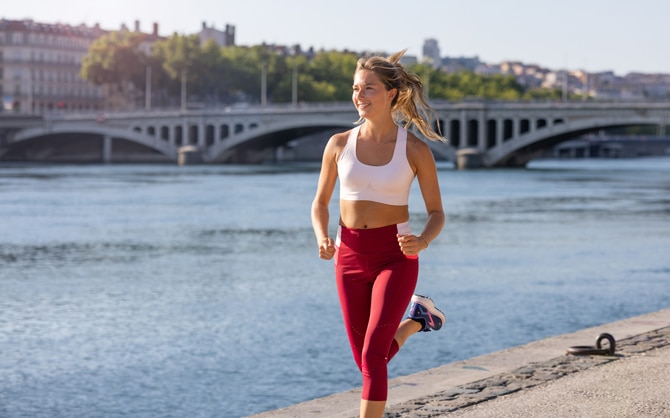
4. Running can help your sleep
One impact of the pandemic has been a lack of sleep, as worries about the unknown have led to a spike in insomnia. The good news is that running can benefit your sleep. Research published in the Journal of Adolescent Health has demonstrated that in just three short weeks, consistent running can improve your ability to fall asleep. It delivers a dose of fresh air and sunshine, gets you away from your devices, and tires you out just enough to help increase your ZZZs. And we know that sleep is magic — it increases your ability to fight disease, improves focus, boosts your mood, and gives you needed energy to get through the day.
5. Running can help you fight off disease
Going back to those cardiovascular benefits, mental health benefits, and muscle and bone strength benefits, running can go a long way in helping you stave off lifestyle diseases. These include heart disease, diabetes and potentially even some types of cancer. The odds are you’ll live a longer, higher-quality life with regular running in your life. Who doesn’t want a dose of that?
Enjoy the wonderful effects of running
What does running do for your body? The answer is clear: The whole-body advantages of running are proven and numerous, and once you get into a regular habit of hitting the pavement or dirt, you’re well on your way to better overall health. Most of all, running is fun, so grab your shoes, your friends, and map out a route to reap all its unexpected benefits.
Our writer’s advice is intended for informational or general educational purposes only. We always encourage you to speak to your doctor or healthcare provider before making any adjustments to your running, nutrition or fitness routines.

Sweat the small stuff
Sarah Bair’s tips will help you start your run safely and understand how to avoid running injuries. If you want an extra boost during your run, make sure you have a good set of shoes and clothes!
Need help finding the right shoes? Check out our Shoe Finder. As someone who takes care of high-level runners on a daily basis, Sarah Bair will be the first to admit it can be easy to overlook the little things.
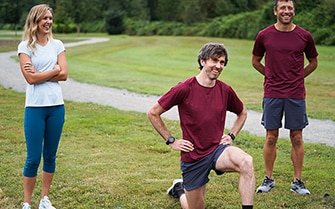
Left to right: athletic trainer Sarah Bair, Brooks Beasts pro runner Garrett Heath, and coach Danny Mackey.
Don’t ignore your body. Stop for a few minutes to address something small and you could save yourself lots of time and pain in the future.”
“I should have enjoyed more pain-free hiking on our trip and not needed all the time off. The biggest takeaway from this experience was to slow down and do the little things right. Don’t ignore your body. Stop for a few minutes to address something small and you could save yourself lots of time and pain in the future.”
The most common running injuries
There are a few common running injuries that physios and GPs see in their practices more often than others. Here are the most common running injuries and the best ways for preventing these running injuries.
Runner’s knee
Runner’s knee is by far one of the most common running injuries, sometimes also called patellofemoral syndrome. It refers to pain at the front of your kneecap, or around your knee, and is usually an overuse injury. The pain from this knee injury from running can vary in severity but it usually always gets worse when running, squatting or climbing stairs. To prevent this type of injury, you should incorporate strength exercises into your routine, particularly focused on your quads and core. You should ensure you’re wearing the right shoes for you, with plenty of support, and avoid overtraining. Instead, build up your mileage gradually and sensibly by following a training plan. If you are struggling with a knee injury from running, there are some running shoes that can help with knee pain.
Plantar fasciitis
Plantar fasciitis is one of the most common running foot injuries. It’s characterised by pain or irritation in the thick band of tissue (known as fascia) on the bottom of your foot, which is typically more painful first thing in the morning. The fascia acts as a spring when you’re running and increasing your mileage too quickly can put it under too much stress so to prevent this common injury you should, again, ensure you increase mileage slowly. If you have weak or tight calves, you can also develop plantar fasciitis, so make sure you become well acquainted with your foam roller.
IT band syndrome
Your iliotibial band, otherwise known as your IT band, is a long ligament that runs all the way from your hip to your shin along the outside of your leg. One of the most common symptoms of ITB syndrome is pain that’s felt on the outside of your knee, which leads many runners to mistakenly think they have a knee injury. Weak glutes, as well as overtraining, are often the cause of this common running injury. So, to prevent ITB syndrome, be sure to hit the gym and focus on hip thrusters, glute bridges and squats.
Shin splints
If you feel tenderness and pain in your shins after a run, you could be suffering from shin splints. Beginner runners are most susceptible to shin splints, but those returning from injury may also experience them if they’re tempted to amp up the mileage too soon. To prevent shin splints, follow the 10% rule when it comes to increasing your mileage – that is, only increase the distance you run each week by no more than 10%. You might also want to get your gait analysed and if necessary, switch to a support shoe that limits pronation or offers arch support.
The key three things to prevent running injuries
To help runners avoid injury, Bair focuses on three key mechanisms: soft tissue elasticity, joint mobility and muscle activation.
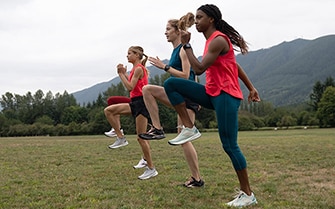
Soft tissue elasticity
When you increase soft tissue elasticity, which is a muscle’s ability to reach its full range of motion without restriction, you can improve muscle flexibility.
We all know that person who can bend over and put their palms on the floor, while others may barely be able to reach past their knees. You might think the answer to this problem is to spend more time stretching. While stretching is one way to increase muscle elasticity, it is not the only solution.
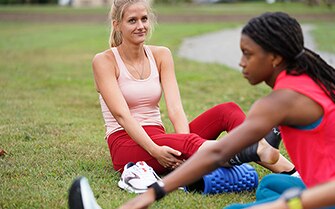
Joint mobility
Joint mobility is the range of movement unrestricted by surrounding ligaments, tendons and muscles that occurs where two bones meet.
Restriction of movement in a joint can cause muscles and other joints to work on overdrive, possibly leading to injury.
We are all built differently, and it is important to remember that one person’s mobility doesn’t have to match yours.
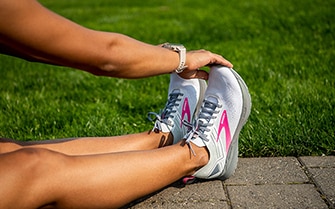
Muscle activation
The recruitment of a targeted muscle group to function during motion is called muscle activation.
Running requires lots of different muscles to work together through patterns of shortening and lengthening. If one of these muscles isn’t working in the right pattern, it can cause a rift in the chain, leading to an uneven gait pattern and potentially injury.
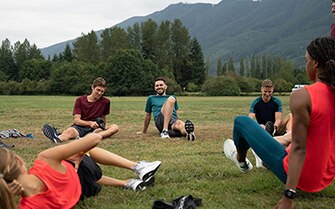
Safe and fine running by avoiding running injuries
If you’re suffering from knee pain from running, why not try Brooks’ Ghost 15 Cushioned Running shoe. Or check out our range of other running shoes.
Takeaway: If you want to increase muscle activation, you need to increase tissue elasticity and improve joint mobility first. Then you can get your muscles fired with dynamic drills such as high knees and butt kicks or resisted drills like lateral band walks or clamshells.
Ghost vs Ghost Max: What you need to know
13th November, 2023 | 8 min. read
By Brooks Staff
Your Content Goes Here
You may already know that Brooks’ cushioned running shoes offer pillowy protection for kilometre after kilometre of distraction-free comfort. But how does the new Ghost Max compare?

The Max series and the vital role of cushioning
The technology behind the new “Max” versions of various Brooks running shoes emerges from our in-depth understanding of what many runners truly crave—maximised cushioning for optimal comfort and protection. In fact, high-quality cushioning not only enhances a runner’s comfort but can extend endurance, reduce post-run recovery times, and significantly reduce the impact forces that travel up through the body and contribute to injuries over time.
Our Max running shoes, including the fast and springy Hyperion Max, signify Brooks’ commitment to this understanding. They’re not just shoes; they’re a promise, helping to ensure that every footfall is softer, every kilometre more comfortable, and every run distraction-free. We have gone above and beyond to achieve the right balance in the Ghost Max, making it the ideal soft and neutral option for runners who prioritise protection.

Ghost vs Ghost Max: A side-by-side comparison
As you might expect, the Ghost and Ghost Max are closely related yet subtly different. Let’s see how they stack up against one another in four key aspects.
- Protective cushioning: Ghost Max’s GlideRoll Rocker works with our DNA LOFT v2 midsole technology—which is also featured in the Ghost—to cushion every landing and help reduce pressure underfoot. That makes it the ideal choice for runners seeking protection for their feet and knees.
- Easy transitions: Ghost is rightly renowned for delivering a seamless heel-to-toe transition with each stride, helping runners achieve an effortless flow. The Ghost Max takes transitions to the next level, utilising the unique GlideRoll Rocker to again actively facilitate the heel-to-toe movement and help protect runners as they roll through each stride.
- Stable ride: Ghost helps to ensure a balanced and stable ride, a hallmark of the Ghost series. The Ghost Max features a broader base to maximise the protection offered by a stable ride, especially for runners with neutral strides.
- Carbon footprint: The Ghost 15 and Ghost Max are both certified CarbonNeutral®.
Ghost: The legacy continues
The Ghost series stands as a testament to Brooks Running’s dedication to continuous improvement. Building upon each iteration, Ghost features a design grounded in feedback from runners all over the world.

- Comfort collar: Tailored specifically to prevent chafing, the comfort collar offers gentle padding around the heel and ankle, ensuring a snug fit without any discomfort.
- External reinforcement: An adaptive fit is made possible through external structures, providing added security and a more structured feel.
- Silicone eyerow: Ensuring that laces remain secure, the Ghost features a soft yet grippy silicone eyerow that’s gentle on the fingers during those quick tie-ups.
- Classic DNA midsole: Ghost 15 features DNA LOFT v2 midsole technology, offering both the plush comfort required for long runs and the responsiveness needed for speed training.
Every feature in the Ghost is an evolution of years of research, ensuring it isn’t just a shoe but a running companion.
Ghost 15 explained by Brooks
Ghost Max: To the MAX and beyond
Featuring a series of thoughtful design choices, the Ghost Max is tailored specifically for runners who want or need plenty of protection built into their running shoes.

- Super-stacked DNA LOFT v2 foam: Offering supremely soft landings, DNA LOFT v2 foam is designed to provide a plush, protected feel without compromising on responsiveness.
- GlideRoll Rocker technology: This exclusive feature is designed to provide a shoe-assisted transition from heel to toe, which in turn helps to reduce pressure under the forefoot.
- Double jacquard warp knit: The two-colour design detail is not just aesthetic; it is engineered for softness, breathability, durability and flexibility.
- Carbon neutrality: As a certified CarbonNeutral® shoe, the Ghost Max doesn’t just take care of your feet but the planet as well.
Ghost Max explained by Brooks
Keep it classic or MAX your comfort
Every runner is unique, and choosing between the Ghost and the Ghost Max truly depends on individual preferences. If you cherish tradition, the Ghost stands tall with its time-tested design, honed through multiple iterations, and remains a versatile choice for varied running experiences, from casual jogs to intense marathons.
On the other hand, if you prioritise protection above everything else, the Ghost Max is your go-to. With its increased heel and forefoot cushioning and features like the GlideRoll Rocker, the new Ghost Max is all about max protection.
In the world of running, both shoes have their place. The Ghost continues its legacy of reliable performance, while the Ghost Max tweaks the winning formula to maximise comfort and protection. Whatever your choice, lace up knowing that you’ll run happy with Brooks.
Advice & Tips
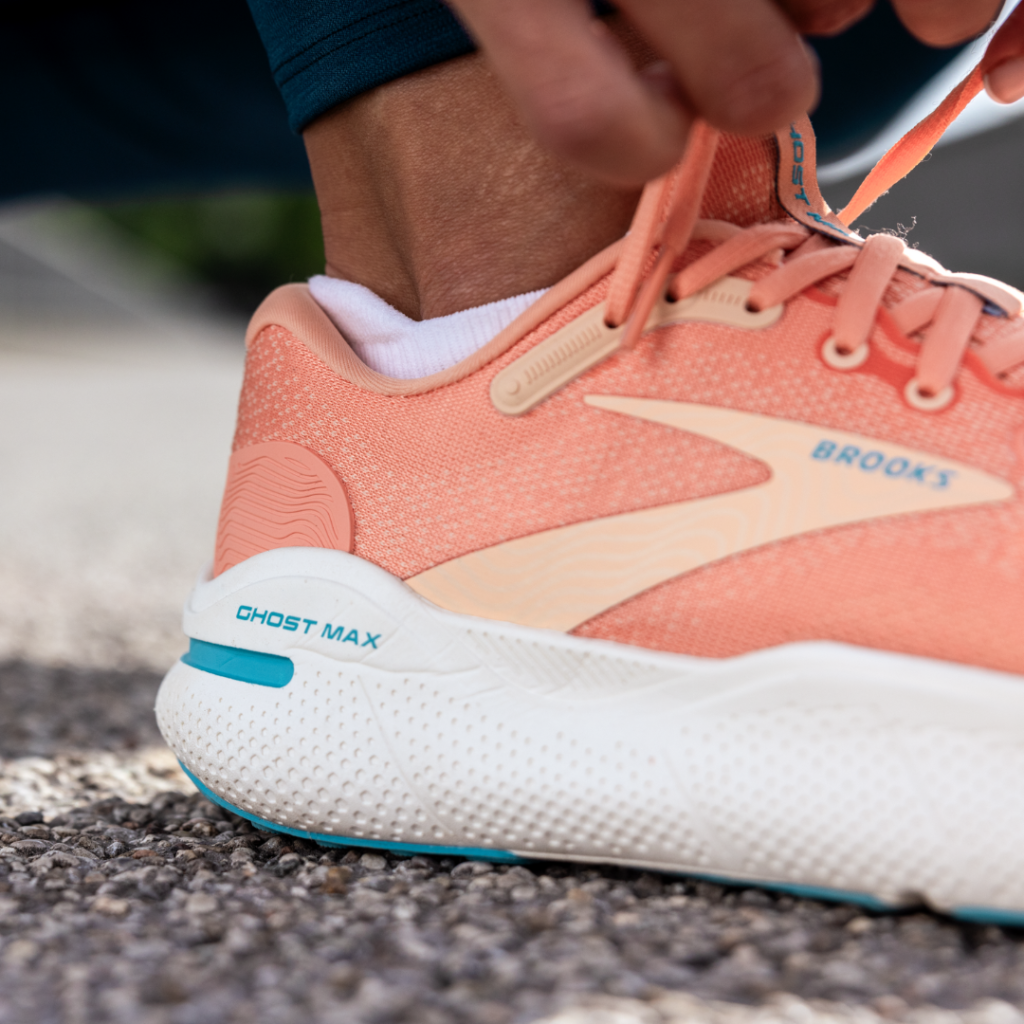
What is heel pain (plantar fasciitis) after running?
Plantar fasciitis is the most common cause of heel pain for runners. But what exactly is it?
The plantar fascia is a thick band of ligament that runs along the bottom of the foot, connecting your heel to the front of your foot. It supports the arch of your foot while you walk and helps to absorb the impact of your feet hitting the ground. Sometimes, the plantar fascia can become irritated, which leads to a sore heel and stiffness when you walk or run. There is some debate among doctors as to what causes this pain. It was long thought that plantar fasciitis is caused by inflammation of the plantar fascia, but it’s also been found to be caused by a thickening of the fascia ligament, and a weakening of the collagen fibres surrounding the fascia.
Plantar fasciitis can be very painful. The main symptom is a sharp, stabbing pain, or deep ache in the heel, or along the arch of the foot. Some people might also feel a burning sensation across the bottom of their foot, extending outwards from the heel. Other symptoms include:
- Pain that’s much worse when you first start walking in the morning after waking up, or if you’ve been sitting or lying down for some time
- Finding it difficult to raise your toes off the floor
- Pain that feels better when you’re walking or running, but comes back after resting
- Difficulty climbing stairs

What causes heel pain when running or after running?
We’ve already mentioned that plantar fasciitis can be caused by inflammation of the plantar fascia, or by a thickening of the ligament. But what causes this to happen?
One of the most common reasons for plantar fasciitis when running is doing too much too soon, or overtraining. If you’re not used to running long distances, or on several days a week, and suddenly ramp up the mileage, then you may suffer from an injury like plantar fasciitis. You may also develop plantar fasciitis if you fail to stretch your calf muscles before and after you run or develop tight calves or Achilles tendons through running workouts like hill repeats and speed sessions. If your calves are extremely tight, they can pull on the plantar fascia ligament, resulting in heel pain.
Some people suffer from plantar fasciitis because of the gear they’re wearing. Old, worn-out shoes don’t provide enough arch support, which could result in injury – especially for people who already have biomechanical issues, like flat feet or high arches. Similarly, if you wear high heels all day, and then switch into running shoes without adequate support, you may end up with heel pain.
Some other things that increase the risk of developing plantar fasciitis include:
- Being overweight or obese, as the weight bared by the plantar fascia is increased
- Ageing, as the enthesis (the insertion of the ligament into the bone) becomes more brittle with age, increasing the risk of injury
- Limited ankle dorsiflexion
- Limited mobility in the extension of the big toe
- Standing for long periods of time
Other causes of heel pain after running
Although plantar fasciitis is the main cause of heel in your plain after running, it’s not the case for everyone. Other causes include:
- Achilles tendonitis, an inflammation of the Achilles tendon (the band of tissue that connects the muscles in the lower leg to your heel bone), that can cause pain, swelling and swelling in the heel.
- Tibialis posterior tendinopathy: Like Achilles tendonitis, the posterior tibial tendon (which attaches the calf muscle to the bones on the inside of the foot) can become inflamed.
- Stress fracture: There are several different types of stress fractures that can cause heel pain after running similar to plantar fasciitis, including a calcaneal stress fracture (when there are several small breaks in your heel bone, often brought on by repetitive activities such as running), and navicular stress fractures (the bone at the top of the middle part of your foot, which can be put under a lot of pressure when running or walking a lot).
- Wearing running shoes that aren’t the right fit for your pronation type can place increased pressure on the plantar fascia and heel pain.
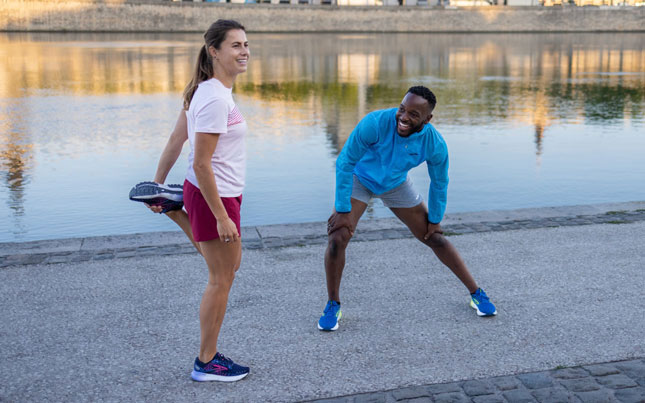
How to prevent sore heels after running
If you have plantar fasciitis from running, there’s one question you’ll be desperate to know the answer to: how can you make the pain go away? Prevention is better than cure, so here are our top tips for preventing sore heels in the first place.
Rest
As much as runners hate to hear it, rest really is one of the best cures for plantar fasciitis – for mild cases, at least. If you have heel pain after running and you don’t rest up, you run the risk of making it worse. It’s important to rest when recovering from any injury, and heel pain is no different.
Taking a break from running will help to reduce the inflammation or thickening of your fascia, which will in turn reduce the pain you feel. Once your symptoms have cleared up, you can start running again – but take it easy, as jumping straight back into long distances or lots of speedwork could ignite your injury again. It can be frustrating, but resting could make the difference between a short-term case of plantar fasciitis and a long-term injury.
Reduce your load
If you keep getting recurring bouts of heel pain after running, it’s wise to reduce your running load. Try running on softer surfaces like grass and trails to reduce the amount of impact on your heels and ligaments and consider replacing one run each week with a cross-training session instead such as swimming or cycling.
Plantar fascia stretch
Sit with both legs outstretched, then place a towel around the ball of the affected foot. Keep your heel in contact with the ground, then pull the towel towards you until you feel a stretch in your plantar fascia along the bottom of your foot, and the back of your calf. Hold the stretch for 20 seconds and repeat a few times.
Toe stretch
Sit in a chair with the affected foot crossed over the knee of your other leg. Hold your toes with one of your hands, and gently pull them towards you until you feel a stretch in the arch of your foot. Hold for around ten seconds and try massaging the arch of your foot with your other hand.
Calf wall stretch
It’s a good idea to stretch your calves as well as your plantar fascia, and this stretch targets both. Place your hands on a wall, then place the toes of the affected foot against the wall, with your foot at a 45-degree angle. Keeping the heel of the affected foot against the ground, bend your front knee while moving your body closer to the wall until you feel a stretch both in the back of your calf and the bottom of your foot. Hold the stretch for 20 seconds and repeat several times.
Gastrocnemius and soleus muscle stretches
These are the two main muscles in your calf and stretching them both will help to improve the symptoms of plantar fasciitis, as well as making it less likely to return in the future. To stretch your gastrocnemius, stand facing a wall, and place both hands on the wall at eye level. Step back with one leg, keeping your heel on the floor and turning your foot inwards slightly. Keep the back leg straight and start to bend the knee of your front leg, and slowly leaning forward from your hips so your chest moves in the direction of the wall. Do this until you feel a stretch in the back of your calf, then hold for 20 seconds. Repeat several times, then swap legs. To stretch your soleus, repeat the gastrocnemius stretch, taking the same stance. This time, when you bend your front knee, also bend the knee of your back leg. You should feel a stretch deeper in your calf muscle. Again, hold this for 20 seconds, repeat a few times, then swap legs.
Calf raises
This exercise should help you to strengthen the muscles in your calves and your feet. Stand in front of a wall, and place your hands on the wall lightly, for balance. Come onto your tip toes, lifting both heels off the ground. Then, when you’ve raised your heels as far as is comfortable for you, begin to slowly lower then back down to the ground. Do as many as you feel comfortable with to begin with, but the aim should be around three sets of 10-15 repetitions.
Change your shoes
Your running shoes can make a big difference if you get sore heels from running – but it also makes a difference what shoes you wear when you’re not running. Walking around your house barefoot or wearing shoes with minimal arch support when out and about can make your condition worse.
The most important things in a pair of running shoes for plantar fasciitis are arch support and cushioning for your heels. Something like Brooks’ Adrenaline GTS is the perfect choice for runners struggling with heel pain after running, as lightweight DNA LOFT v2 cushioning delivers softness underfoot, while our innovative GuideRails® support technology helps to align the body in its natural movement path, keeping excess movement in check.
Wear proper running socks
Running socks tend to have padding in the heels, which can help to offer some comfort and an extra layer of protection while you have issues with your heels. You can even get socks that are designed specifically for plantar fasciitis, with compression zones to support your heel and Achilles, while giving you the range of motion you need to run comfortably.
Wear night splints
Your physiotherapist or doctor may recommend trying night splints. Plantar fasciitis is often worse in the morning as the plantar fascia gets shorter overnight and doesn’t like suddenly being stretched in the morning. Night splints keep your plantar fascia stretched out overnight, so it’s less painful when you try to walk on your rested feet.
Taping
If you have mild plantar fasciitis, and want or need to keep running, you could try taping your feet with kinesiology tape. This supports your ligaments, helping to stabilise your plantar fascia and supporting the arch of your foot.
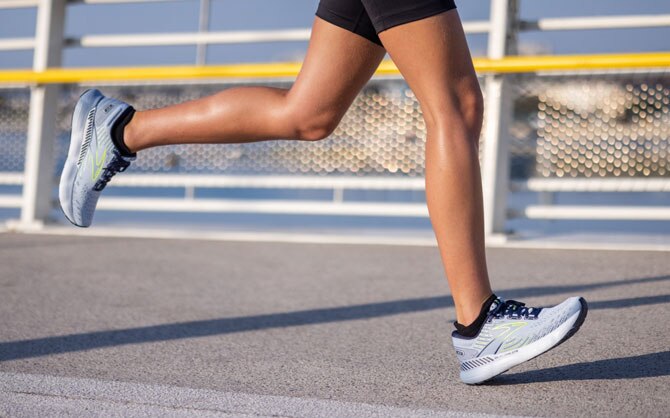
Can you run with plantar fasciitis?
Another key question you’re probably asking yourself is: can I run with sore heels after running? You’re not going to like the answer, which is: it depends. If the pain is relatively mild, then you’re probably okay to keep running – but you should keep the distances short and avoid any hard efforts while you’re suffering with the symptoms of plantar fasciitis or any other type of heel pain. However, it’s important to keep an eye on your pain levels over the next 24 hours after your run. If it gets worse, then it’s a sign that you should take some rest rather than trying to push through the pain. If your heel hurts after running, it’s better to take some rest – and to seek advice from a medical professional.
When should you visit a doctor for sore heels after running?
As runners, we can all be guilty of ignoring a niggling pain and just running through it. Sometimes, that’s the right thing to do – and sometimes it’s not. So, when should you see a healthcare professional because of your heel pain after running?
If the pain persists for more than a week or two, it’s a good idea to see a doctor or physiotherapist. They’ll ask you about your symptoms and when you experience heel pain after a run, as well as finding out what treatments you’ve already tried to relieve the pain. They may prescribe rest, but they might also suggest other types of treatment such as specialist orthotics, cortisone injections, anti-inflammatory medicine, shock-wave therapy or even surgery for severe cases. Surgery is a last resort and will usually only be suggested if no other treatments have worked for you.
Reducing heel pain when running
Heel pain after running can be a real… well, pain. At best, it can cause discomfort on the run, and at worst, it can be completely debilitating. If you suspect you have plantar fasciitis, it’s best to consult with a doctor or physiotherapist, who can diagnose what type of heel pain you’re experiencing, as well as recommending the best course of treatment for you. If you have mild heel pain, you may be able to keep running – but in most instances, the best treatment is rest and stretching. Stay patient, and you’ll soon be out running happy again!

As runners, we love the sport. And often, running gets elevated in our minds to a somewhat infallible and mythical state. Running can do no wrong. It’s empowering and improves our minds and bodies in an amazing way. Which is absolutely true.
It’s also true, however, that running injuries are troublingly common. In fact, researchers at Yale Medicine estimate that at least half of all regular runners will deal with some sort of injury each year. So, if you maintain your running habit for many years, chances are pretty high you will be injured, in one way or another, at some point.
The trick to recovery, it turns out, is maintaining a positive attitude. Doing so has actually been known for a very long time to improve recovery time in all sorts of situations.
Shift your focus to recovery
Generally, if I asked you — or any other runner, for that matter — what your current goals were, you would likely answer with something like “improve my mile pace” or “complete a marathon”. You know, something runnerly. When recovering from a running injury, though, things are a little different. Or, at least, they should be.
Imagine, for example, you’re already dealing with an overuse injury like Achilles tendinitis, also known as the somewhat ominous “runner’s heel“. Like other common running injuries, this particular situation is caused by the repetitive and stressful act of smashing your feet into the ground over and over again. You know, the thing we call running. What do you suppose would happen, then, if you continued to push through the pain and pursue your goals of faster, longer runs? It’s clear the swelling will not get any better. Rather than sticking to your typical focus, goals and mindset, then, a change is in order. When recovering from running injuries, your new goal is simple: Recover.
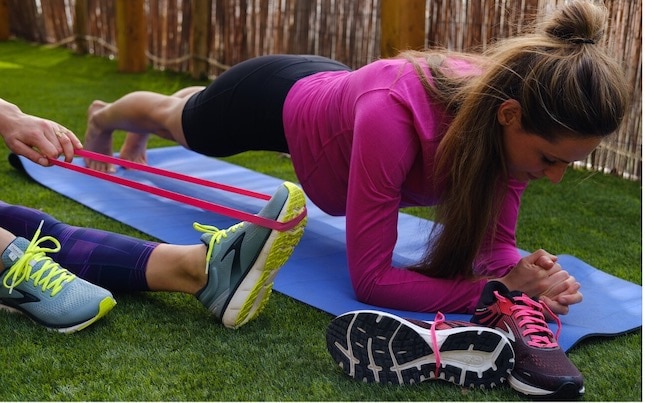
Armed with the reassurance that I was only dealing with shin splints, I kept following my normal workout routine. And started to get slower. Not only did my speed decrease, but my overall endurance did as well. All the while, the pain in my shins after running didn’t go away. What was the problem? I had refused to accept the new reality of my fitness world and tried to stick to my existing goals. Eventually, I took some time away from running completely, which was a game-changer. During that time, I focused on recovery. Rather than being running-centric, my goals started to revolve around my flexibility, balance and pain levels. Eventually, the pain went away, and I was able to get back to my runs as a better, more patient runner.
If (or when) you deal with a running injury, do not minimise it or try to power through. Instead, see this as a different stage in your training and adjust your thinking and goals to embrace the opportunity to recover.
Cross-train to stay mobile
One way this shift in thinking may manifest itself is through cross-training. Runners run, and we don’t tend to spend a lot of time in other athletic pursuits. Remember, though, most athletic injuries are classified as overuse injuries. Meaning the issues are directly related to the focused and repeated effort of running. Often, these injuries can be strong indicators that you’re lacking in some other aspect of your fitness like strength, balance or mobility.
While training for my first official race, I again fell into the overuse trap and developed an injury. This time, the culprit was a strained calf. Based on previous experience, I knew that running through it wasn’t the answer. I had at least learned that much. Weightlifting, my other training modality of choice, didn’t really help the situation, though. Lifts that focused on my calves seemed to make things worse. So, the question was this: How can I continue to get cardiovascular training and encourage my calves to heal without putting any additional strain on them?
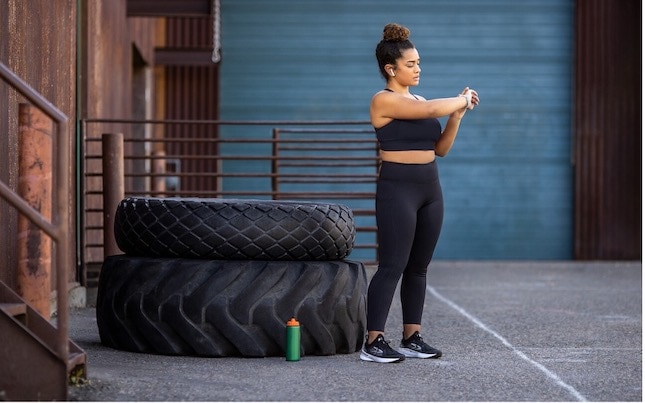
So, while an injury can be frustrating, it can also be a reminder that your training is lacking in some areas. After all, fitness is a multifaceted thing, and running, wonderful as it is, simply doesn’t address all of those aspects of your training. During your running injury recovery, use that time to cross-train and focus on whatever insufficiencies you might see in your training. Not only will this keep you moving forward in your overall fitness journey, but it will also prevent you from sinking into any discouragement you might otherwise feel while taking time away from running.
If you’ve been inspired to try cross-training to help with your running injury recovery, explore through our Brooks Shoes to get you started with the right gear.
Leverage a support system
As mentioned earlier, most runners will deal with some sort of injury during their athletic careers. It’s not great, but it’s the truth. And one of the consequences of running injuries is that you can start to feel isolated. Maybe you used to run with a group and, because of the injury, you just can’t anymore. Or maybe the injury has just thrown you off your game and you don’t feel like yourself, lacking the motivation to get up and do anything. Whatever the case, the physical impact of running can also affect you mentally and emotionally. Frustratingly, this can also create a bit of a vicious cycle wherein you feel bad because you can’t be as active as you used to be and you aren’t as active as you used to be because you don’t feel well.
During these seemingly dismal days, a supportive community of family and friends can be incredibly valuable. And, it’s important to note this support system may or may not consist of other runners. Of course, runners who have experienced something similar might be a good source of encouragement and advice, but that’s not entirely what the community is about. Mostly, it’s just about getting you out of your head and preventing you from wallowing. The simple act of being around people can help you stay positive while dealing with running injuries.
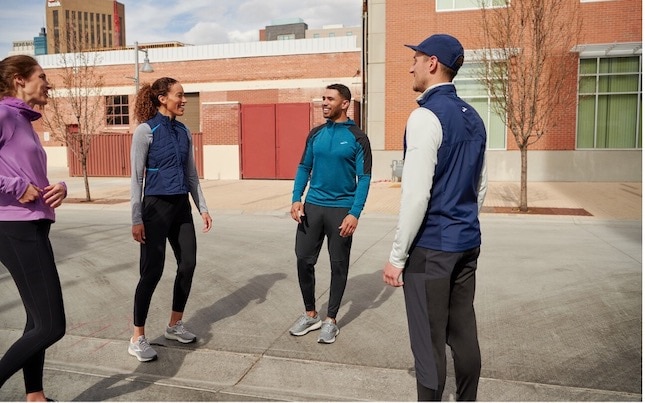
Whatever form this support system takes, the important thing is you fight the urge to be totally inactive and isolate yourself. This can be a real danger when you’re told to rest an injured limb or joint. Remember, rest doesn’t mean inactivity, and recovery can — and should — be active. Staying active and spending time with family and friends can go a long way toward maintaining a positive attitude while recovering.
Put yourself on the path to future success
As runners, we push ourselves physically and mentally all the time. And, while this does allow us to improve in a variety of ways, it can also open us up to the risk of injury sometimes. If you do suffer an injury at some point, though, remember that it’s by no means the end of your running career. Instead, view the recovery period as just another phase of your training. Take that time to cross-train and focus on any potential gaps in your usual routine. Recovery periods can also be a perfect time to strengthen your connections with your community of family and friends. These steps can help you stay positive even when you’re recovering from a running injury.
Our writer’s advice is intended for informational or general educational purposes only. We always encourage you to speak with your doctor or healthcare provider before making any adjustments to your running, nutrition or fitness routines.

What is cramping?
Cramps are considered one of the most dreaded pains during or after running. But fear not, as they are usually minor and go away quickly if you take some simple proactive steps, which we’ll cover below. Cramping can be loosely defined as a severe contraction of a muscle (or muscles) in the body and is most commonly caused by dehydration and overuse, especially when it comes to running. Knowing that cramps are a fairly common part of running and where they most commonly occur can help you minimise them. And when they do hit, you have a better chance of treating them.
Muscle cramps
There are some common muscle cramps for new runners, as certain muscles take on more of the load of running than others. Calf muscles are notorious for cramps, and the most common cause of leg cramps after running. These muscles take plenty of stress on each step because they play a key role in both propelling you forward and absorbing the impact as your foot hits the ground. Other common muscles that can cramp up include the hamstrings, quads, and the muscles in the arch of your foot.
Stomach cramps
Stomach cramps are technically muscle cramps but are usually caused by shallow breathing or eating or drinking too much before your run. Runners experience both abdominal cramping and what is commonly referred to as “side stitches”. As the name implies, a side stitch is cramping on the side of your body right below your ribs.
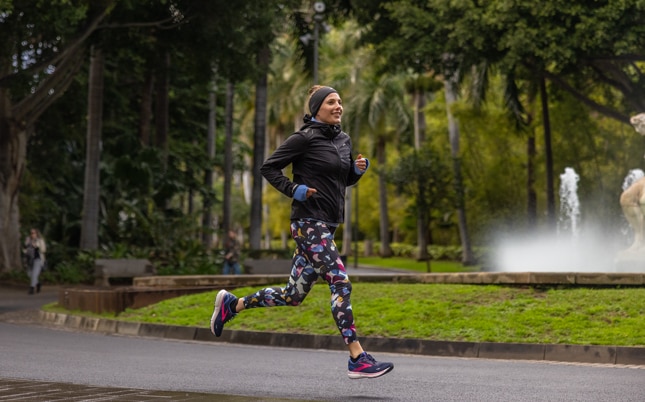
How to avoid cramping
There are some simple steps you can take to reduce your risk of cramping during or after your run.
- Drink plenty of water, but not right before a run. Drinking water helps keep the body hydrated, and staying hydrated greatly reduces your risk of cramping. Try to drink plenty of water, about 2–3.5 litres (or 10–15 glasses), throughout the day. However, to avoid period like cramps after running, drink no more than 120–175 ml within 15 minutes of your run. You can also supplement with electrolytes to replenish what you lose while sweating. Finally, bring a water bottle on your run and take sips throughout, especially on a hot day.
- Breathe. We all breathe without thinking about it, but when you’re out on a run (especially a tough one), it’ easy for your body to tense up and take shallow breaths. When you feel fatigued, it’s important to relax muscle tension and take deeper, more conscious breaths. This delivers more of that much-needed oxygen to your muscles.
- Start out slow. If you’re new to running, this simple step is key. Your muscles have not yet adapted to the stress of running, so it’s important to start out at a slow, controlled pace. Equally important is to ease your way in and find time to recover. Take rest days, and don’t add on more than 10% of your running volume from one week to the next.
At some point in your running journey, you’ll likely experience cramping. I wish I could say otherwise, but it’s just a part of exercise. Following these simple steps can help reduce your risk of cramping and limit other pains after running. Remember to breathe, take it easy, and drink plenty of water!
If you’re still experiencing running cramps after trying the tips in our blog, check out our running shoes and clothing, to get started with the right kit.
Our writer’s advice is intended for informational or general educational purposes only. We always encourage you to speak with your doctor or healthcare provider before making any adjustments to your running, nutrition or fitness routines.
The GlideRoll rocker – it’s science
We engineered the shape of the Ghost Max to actively roll forward from the moment your heel lands to when you push off on your toes.
Launching in South Africa in January 2024.

